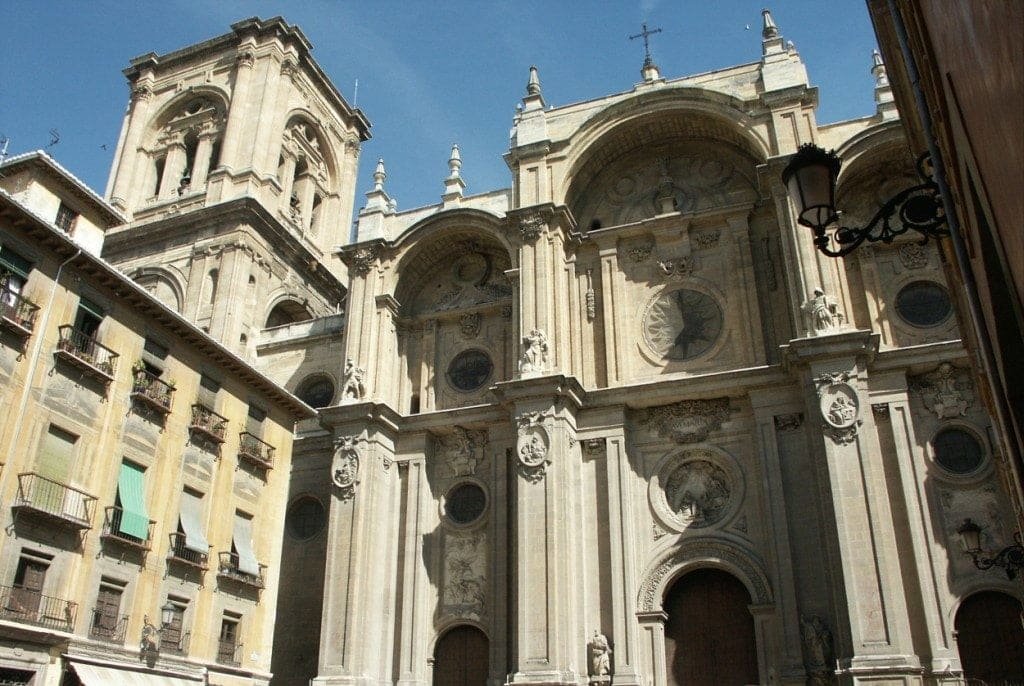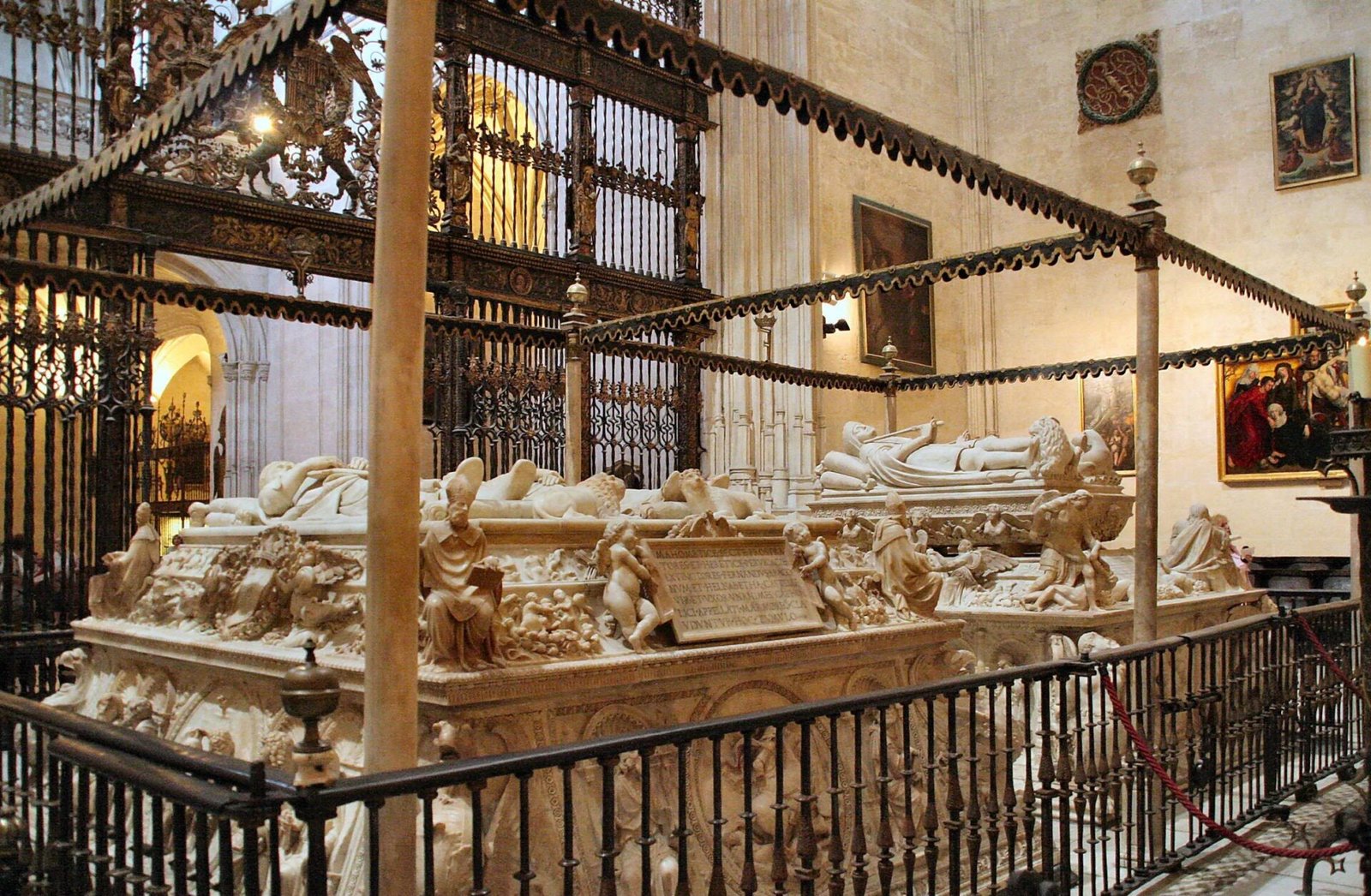The Royal Chapel of Granada is situated between the Granada Cathedral and the Church of Sagrario, Built in Isabelline Gothic style, Were the Catholic Monarchs were buried. The monarchs died before the chapel was finished, and their bodies rested in the convent of the Parador Nacional de Turismo until the Royal Chapel was completed.
They chose to be buried in Granada because they saw its conquest as the crowning achievement of their reign. Construction began in 1505 following a design by Enrique Egas and was completed in 1521.The northern facade is designed by Garcia Pradas, and provides access to the interior; a plan in the shape of a Latin cross with four side chapels.
The crossing with the Royal Mausoleums was designed by Master Bartolomé and is separated from the rest of the naave by wrought, the tomb of the catholic monarchs on the right was built by Domenico Fancelli and the the tomb on the left was built by Bartolomé Ordoñez, who used carrar marble for his design.
You can also find painting belonging to Queen Isabella, The paintings where created by artists such as:
- van der Weyden
- Beruguete
- Membling
- Botticelli.
You can also find Queen Isabella crown and scepter kept together with King Fernando’s Sword.
The original main entrance to the Royal Chapel of Granada is inside the Cathedral. The current entrance to the Royal Chapel is through la Lonja.

Brief Five Hundred Years of History
In the thirteenth of September of 1504, Queen Isabella and King Ferdinand decided that Granada will be their final resting place, so they signed a Royal Warrant for the construction of a Royal Chapel, which will be a brand new burial location brought about the development, decoration, and furnishing of the building. Built in Gothic style between 1505-1517 and dedicated to Saint John the Baptist and Saint John the Evangelist.
One Year before the start of the Edification of the site, the Queen Died and twelve months before the construction work was completed the King Died, The Royal Chapel already existed as an group with a prime Chaplain and twelve chaplains. The Chapel was decorated and it obtained the precious legacy from the Founders Monarchs: Books, Relics, Tapestries, Paintings, Vestments, Fabrics and liturgical vases
The 16th century was known as the Golden age of the Royal Chapel, during this era the chapel, three levels can be distinguished. its birth shortly before the death of Queen Isabella and its construction during the reign of King Ferdinand. It was the Queens wish to be buried in this Chapel. The second stage means the flowering with Emperor Charles I. The temple is decorated and the institution is strengthened. It means the end of a dynasty, the appearance of the Renaissance, the humanist demonstration of such an impressive historic heroic deed.
The Concordat of 1851 followed by a Royal decree establishing a reorganization of the royal chapels brought a certain stability. With the Restoration a new balance is achieved and an increased interest in historical research, artistic restoration and museums is developed.The first scientific publications on the Chapel and its cultural heritage date from this period.
The Concordat of 1851 followed by means of a Royal decree establishing a reorganization of the royal chapels delivered a sure balance. With the Restoration a new balance is completed and an increased interest in historical research, artistic restoration and museums is evolved.the first scientific courses at the Chapel and its cultural historical past date from this era.
The late eighteen century and early nineteenth century brings new embarrassments to the organization. they’re linked to political changes, financial problems and the profound alternate in church-country relations. The liberal regime ended with the Patronage regime and the unique foundations of the group turns into a fully ecclesiastical entity.
In the twentieth Century the Historical-graphical,architectural and artists grow interest for the Royal Chapel, in 1913 the Chapel Museum was created by the Royal Decree, due to the increase in tourism. New researches are carried out, and the spiritual significance of the chapel for Hispanic awareness is emphasized.
Telephone Number: +34 958227848 | Official Website |
Burials: Isabella I of Castile, Ferdinand II of Aragon, Joanna of Castile, Philip I of Castile, Francisco Pradilla Ortiz, Miguel da Paz, Prince of Portugal and José de
How to get here
The Royal Chapel is situated near the Alcaiceria, the Bib-Rambla square, the Madraza and Plaza Isabel la Catolica.
- By Bus: you can catch the Granada city buses: routes; LAC, C1, C2, SN1 and SN4.
- Walking: about 8 to 10 minutes walk from El Bañuelo.
Opening Hours
[su_table]
| Autumn to Winter | |
| Monday to Saturday | 10:15 AM – 1:30 PM |
| 4:00 PM – 7:30 PM | |
| Sundays and holidays | 11:00 AM – 13:30 PM |
| 16:00 AM – 19:30 PM |
[/su_table]
*Closed: 1st and 2nd January, 12th October – in the morning. Holy Friday and 25th December.*
[su_table]
| September to February | |
| Monday to Saturday | 10:15 AM – 1:30 PM |
| 5:30 AM – 18:30 PM | |
| Sundays and holidays | 11:00 AM – 13:30 PM |
| 5:30 AM – 18:30 PM |
[/su_table]
*Please note: opening times may very during holidays and other events, please visit the official website for more details*
Admission
[su_table]
| Ticket Type | Price |
| General | €5,00 |
| Children | Free Entry |
| Reduced | €3,50 |
[/su_table]
*Please note: prices may change yearly or during holiday and peak seasons, please visit the official website for more details *
Location
Address: Calle Oficios, s/n, 18001 Granada, Spain
[su_button url=”https://isolatedtraveller.com/european-cities/granada/” style=”flat” background=”#000000″ size=”6″ wide=”yes” center=”yes” radius=”0″ icon=”icon: arrow-circle-right”]Explore More Of Granada[/su_button]


